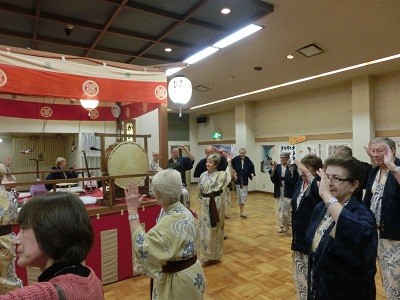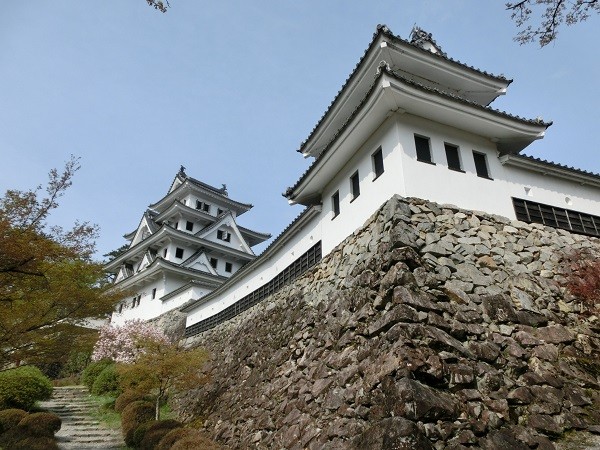Gujo Hachiman (郡上八幡) is an area of Gujo City in the middle of Gifu Prefecture. The population of the city is only about 38,000, but it’s one of the largest cities in Japan at more than 1,000 km2. Gujo Hachiman attracts many visitors because of the castle, beautiful traditional town, food sample workshops, and dance festival.
Gujo Hachiman Castle
During the warring states period, Toshi was the lord of this area and built Shinowaki Castle. Endo Morikazu constructed a fortress on Mt Hachiman and defeated Toshi in 1559. This fortress was the origin of Gujo Hachiman Castle. Endo supported Oda Nobunaga, one of the three unifiers of Japan in the late 16th century, and after Nobunaga died, Endo was expelled.
In 1588, Inaba Sadamichi came to the Gujo Han (domain) and did a big reform of the castle. After the large and important battle of Sekigahara, Inaba supported Tokugawa Ieyasu. Because of this support, Tokugawa became a shogun, and Inaba kept his feudal lord title. Then during the Edo period, the feudal lord of the domain changed a few times, to the Inoue, Kanamori, and Aoyama families.
In 1870, the castle was demolished after the abolition of the Han (domain) system. A lot of castles in Japan were unfortunately demolished at that time by the order of the new government to eliminate the legacy of the feudal system.

Visiting the Castle
In 1933, the castle was reconstructed with wood using Ogaki Castle, which existed until WW2, as a reference. Now, Gujo Hachiman Castle is the oldest reconstructed wooden castle in Japan. Most parts of the stone walls are original. The appearance of the castle on the mountain is beautiful and the panoramic view of the town from the castle is amazing!
Access: 20-minute walk or a 20-minute ride on the bus from Gujohachiman Station to Gujohachiman Plaza. Then a 15-minute walk up the hill to the castle.
Fee: 320 yen for adults / 150 yen for junior high school and elementary school students
Hours: 9 am to 5 pm (from March to May / September to October), 8 am to 6 pm (from June to August), 9 am to 4.30 pm (from November to February)
Closed from December 20 to January 10.
Town of Water
There are channels running through the beautiful old town. These channels were made about 400 years ago for daily-use water. The water either originates from natural springs or from the mountains. Sogisui is one of the sources. The water is still used by the local people, but some areas were renovated for tourism purposes. You can have a comfortable walk along Igawa-komichi and Yanaka-mizuno-komichi.



Gujo Dance
Gujo Odori (Dance) is one of the three big traditional bon dances which started during the Edo period. Every year, they hold the dance for 32 consecutive nights from mid-July to the beginning of September. The period between August 13 to 16 is called ‘Obon’ (お盆) which is when spirits of ancestors come back to earth. Urabone Festival is held to celebrate this. They dance all night long on these 4 nights. The venues vary; they dance in the precincts of temples and shrines, on the street, or in the square. There are ten types of dance.
You can join the dance if you want! If you visit the town outside the dance season, I recommend you to visit the Gujo Hachiman Hakurankan where the staff performs the dance every day. Some local hotels may offer dance experiences, too.

Gujo Hachiman Hakurankan
Gujo-hachiman Hakurankan is a local history, art, and dance museum. They explain the history of the town with panels, life-size figures, and dioramas. There are also art exhibitions such as kimono called Gujo Tsumugi, artistic fishing equipment silkscreen, and modern art by local artists.
Another attraction of the museum is the dance performance. They show it every hour from 11 am to 3 pm for 15 minutes. First, they show you the dance, then you can join them!
The old town around the museum is a nice place to walk. Especially the two major streets Kajiyamachi (blacksmith town) and Shokuninmachi (craftsman town) are recommended.
Access: 25-minute walk or a 20-minute ride on the bus from Gujohachiman Station
Fee: 540 yen for adults / 320 yen for junior high school and elementary school students
Hours: 9 am to 5 pm (during the dance season, they open until 6 pm)
Closed from December 24 to January 2.
Sample Village Iwasaki
Plastic food samples are often displayed in the showcase at the entrance of restaurants in Japan. They are made of wax and synthetic resin. Takizou Iwasaki started to sell food samples in Osaka in 1932. He was born in Gujo Hachiman and he constructed a factory to make food samples in his hometown in 1955.



Adding a showroom next to the factory in 1999, this later became Sample Village Iwasaki. You can see how the staff makes food samples. Then you can try to make them by yourself. There is a variety of fake food that you can make. Examples are lettuce, tempura, noodles, and ice cream. You can, of course, bring them home as a souvenir. The village has a big shop, so you can buy elaborately made products, too.
Access: 10 minute-walk from Gujohachiman Station
Fee: Free to enter. There’s a fee for making food samples. The price depends on what you make.
Hours: 10 am to 4 pm
Closed on Tuesdays
Access to Gujohachiman
From Tokyo, take the shinkansen (bullet train) to Nagoya. Then change to JR Takayama Line (express train ‘Wide View Hida’) to Mino-Ota. Then change to Nagaragawa Tetsudo to Gujo Hachiman. It takes about 4 hours in total.
From Takayama, take JR Takayama Line to Mino-Ota. Then change to Nagaragawa Tetsydo to GujoHachiman. It takes about 3 hours by train or 1 hour by car.
Your Japan Tour
As seasoned Japan experts, we can help you create your perfect Japan tour including destinations like Gujo Hachiman. Check out our group tours and private tours, or contact us to start planning your unforgettable holiday to this fascinating country. Japan is full of once-in-a-lifetime experiences, culture, history, nature, and delicious food!

